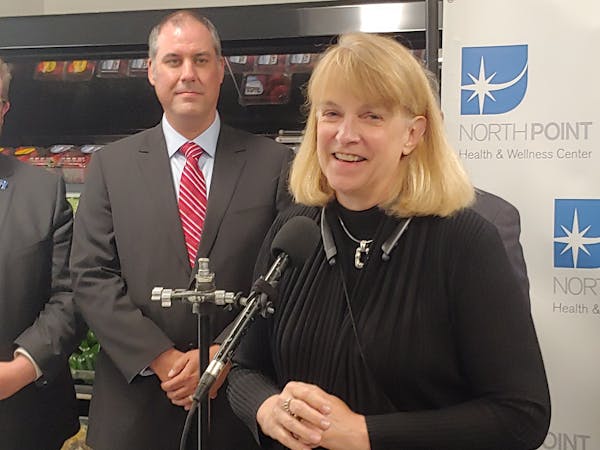About 38,000 people lost Medicaid health insurance coverage at the start of this month as Minnesota began a yearlong process to check eligibility for the roughly 1.5 million state residents who are enrolled in the public health insurance program.
Interpreting the lost coverage figure is difficult because it's likely that some are picking up health insurance from another source rather than going uninsured, Jodi Harpstead, the commissioner of the state Department of Human Services (DHS), said on Wednesday.
It's also likely that some are being disenrolled even though they still qualify for coverage — it's just that their renewals did not occur for reasons that can vary from lost paperwork to missing addresses.
Minnesota and other states have been bracing for sizable losses in Medicaid enrollment as they restart renewals that were suspended during the COVID-19 public health emergency.
Medicaid enrollment in Minnesota grew from about 1.2 million people to 1.5 million people over the past three years, and it could be that more of these new enrollees now have access to job-based benefits than was previously true with Medicaid, Harpstead said.
"So, this is either a very different deal, and it's going just as it should; or it's alarming; or it's somewhere in between and it's a little hard to put the adjective on it," she said in an interview.
"I'm not feeling so alarmed," Harpstead added. "I'm thinking that there's enough reason to believe that people may just not need Medicaid anymore — and that we're in the beginning of a very complicated process that I think will get more robust and better throughout the year."
Medicaid is the state-federal program that provides health insurance coverage for lower-income and disabled state residents. Renewals resumed this summer and will continue for roughly a year.
DHS said that about 97,900 people were in the first group of eligibility redeterminations. Nearly 50,000 people successfully renewed coverage. An agreement with the federal government delayed the process for about 10,000 people whose coverage is based on having a disability, being blind or being age 65 or older.
Coverage stopped, Harpstead said, for about 32,300 people whose eligibility status is unknown because their renewal wasn't completed.
It's likely that some didn't complete forms because they have coverage elsewhere, the state says. It's also possible that beneficiaries didn't realize the importance of completing the process, or didn't receive paperwork because an updated mailing address wasn't on file.
About 5,600 people submitted renewal forms and were found ineligible.
The state's numbers suggest a high share of those losing coverage did so for "procedural" reasons, said Tricia Brooks, a researcher at the Georgetown University Center for Children and Families. That's a problem because many of those beneficiaries — particularly children — likely still qualify for the coverage.
"We've got to do more to make these programs consumer-friendly," she said. "We need to do more to remove these barriers to coverage that result in lots of eligible people not being able to get through the process."
Procedural disenrollments should decline in the coming months, Harpstead said, as Minnesota moves to enroll more people based on information in state databases rather than data on submitted forms.
"The more we can increase our auto-renewal rate," she said, "the better our results will be."
The figures released Wednesday show about 39% of the first 97,900 people slated for renewals lost Medicaid coverage — a higher rate than the 15% to 25% of enrollees previously cited by DHS.
Harpstead, however, said she didn't think this higher lost-coverage rate will apply to future cohorts. The first group to go through renewals, she said, always was going to be the most difficult.
"[It's a] new process — people are just hearing about it," Harpstead added. "I think the process is going to get more robust and stronger every month."
Keeping people on Medicaid was critical during the pandemic, and all states now are busy cleaning up enrollment lists because some people have moved on to other coverage, said Lynn Blewett, a health policy researcher at the University of Minnesota.
Federal estimates suggest that 8 in 10 enrollees will maintain their Medicaid benefits, Blewett said, adding that states have 14 months to complete the renewals.
"Minnesota is in a better position than many states as the Legislature appropriated significant funds to aid in the unwinding process," she said via email.
Harpstead said the state has been spreading the word for months about the renewals process in conjunction with counties, tribal governments, health plans and other stakeholder groups across the state. Outreach has come via direct mail, text messages and in-person contact.
Some counties have put together door-knocking campaigns, she said, while some groups in greater Minnesota are putting up posters in laundromats and food shelves. Some pharmacists as they fill prescriptions are stapling instructions to bags, so patients know where to go to learn about the renewal process.
"It's an amazing, massive effort," Harpstead said.
She expects the word also will spread as patients who've lost coverage realize what's happened, such as when they try filling a prescription. Those who have lost coverage but still are eligible, Harpstead said, can get retroactive benefits for three months once they get back into the program.
"It is not over yet, even for that [first] cohort," she said. "Medicaid is open for business every single day of the week, every month, every year. ... If they lose their coverage Oct. 1, they can come in on Oct. 2 and enroll."
New York City turns to AI-powered scanners in push to keep guns out of the subway system
North Carolina regulators says nonprofit run by lieutenant governor's wife owes the state $132K


